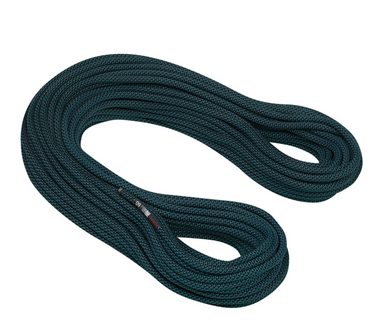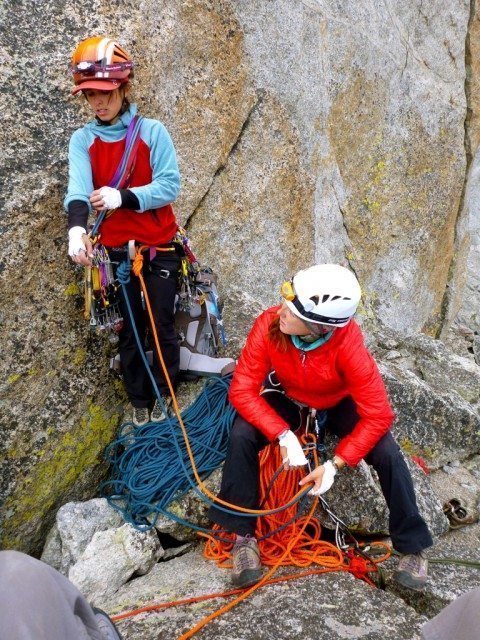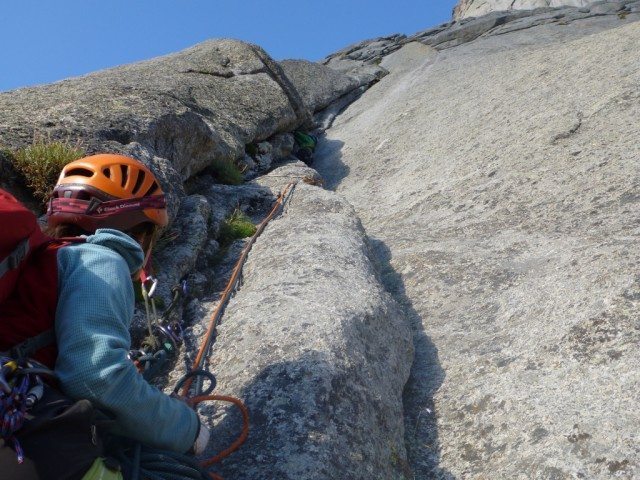
Mammut Nordwand Single Rope, 9.3mm
Elongation at First Fall: 30
Elongation with 80 kg: 6%
UIAA falls: 7-8
Sheat Slippage: 0mm
Impact Force: 8.7 kN
Weight: 58g/m
MSRP: $300
Size Tested: 70m
Days Tested: 20+ days
Locations Tested: Cirque of the Towers, Wind River Range, WY; Old Stage Road, Tarryall Mountains, CO; Moab, UT
I grew up climbing on really fat ropes with the understanding that “the fatter the rope, the safer the rope.” The old-school thinking has always been that skinny ropes are only for high-alpine and other very serious objectives, while fatter ropes are meant to handle the constant abuse of top-roping, cragging, and wandering multi-pitch climbs. When I bought my first rope—an Edelweiss Element (10.3mm)—it was considered to be very skinny by my small community of fellow climbers.
There’s been a drastic shift in this mentality over the last few years as new technologies allow for skinnier and skinnier single ropes that still hold up to general wear and tear. The Mammut Nordwand is definitely of this generation.
Diameter Considerations
The Mammut Nordwand is a single rope that’s also rated as both a half and a twin rope. I first took it to Haystack Mountain and the Cirque of the Towers in the Wind River Range of Wyoming for a 12-day climbing expedition, and in this setting, I used it solely as a half rope in a team of three.
The Nordwand is light and supple enough to function effectively as a half rope, and it’s reassuring to know that it can be used as a single rope in case of an emergency or a rescue.

Weight
While many thicker ropes weigh between 60 and 70 grams per meter, the Nordwand falls into the lighter category of skinnier ropes, weighing in at just 58 g/m. Especially when backpacking in to climbing areas, I definitely appreciated this rope’s light weight.
Yes, there are lighter ropes on the market (the Bluewater 9.3mm Wave weighs 56 g/m and Sterling’s 9.4mm Fusion weighs 57 g/m), but I didn’t find myself wishing for one, and I can’t say that I’d be able to notice a 1- or 2-gram per meter difference.
Use
Mammut suggests that the Nordwand is ideal for mixed, ice and sport climbing, and that it’s “suitable” for alpine, multi-pitch, and gym climbing. I agree wholeheartedly.
My only caveat to this statement is that the Nordwand would make an excellent rope for red-pointing very difficult climbs, where weight is a big issue. But for reasons of durability, I don’t think it’s the ideal rope for more casual or high-frequency sport cragging. (More on that in a bit.)
Handling
The Nordwand’s handling is one of its best features. It runs through various belay devices very smoothly, with minimal kinking. Even after several harsh routes and a few days of heavy top-rope belaying, it hasn’t become twisted at the ends. When I used the Nordwand as a half rope over wandering and traversing routes, it handled excellently, and its small size (when coiled) was ideal for stacking, flaking, and managing on small and awkward belay ledges.
This may be a product of Mammut’s COATINGfinish, which helps to reduce friction between the rope and the belay device. In a previous review, Dave Alie noted that Mammut’s Infinity Single Rope, 9.5mm (which also has the COATINGfinish), handled exceptionally well.
Then there’s the “Double Twist Technology,” which Mammut claims creates a very fine sheath surface and improves handling. While I definitely agree that the Nordwand is highly flexible, smooth, and easy to use (especially when compared to thicker ropes), it’s handling is comparable to that of the Petzl Fuse, 9.4mm. This makes me think that a rope with a smaller diameter will generally handle better than rope with a larger diameter.

Rope Stretch
I think the Nordwand strikes a good balance when it comes to rope stretch. It’s not as static as a thicker single rope such as the Edelweiss Element, and with a static elongation of 6%, top rope falls never feel too long.
In the Winds, we used the Nordwand with Sterling’s Marathon Half Rope (8.8mm). Unlike the Nordwand, the Marathon has a static elongation of 11%, which often felt much too stretchy for the second climber and made for long top rope falls.
Dry Treatment
Luckily, I haven’t had to use the Nordwand in extremely wet conditions. Unfortunately, this also means I haven’t had the chance to fully test its dry treatment. That said, I’ve now used it during two snow storms and once when the sky was spitting rain. In each of these cases, the Nordwand worked very well and handled quite smoothly.
The COATINGfinish has also done a good job keeping the Nordwand clean. Even after a beating in the Winds, a few days of cragging, and some desert climbing, the rope is still pretty much dirt-free. It seems to have kept dirt out much better than my Edelweiss Element.
(For more of an explanation on this PTFE-based dry treatment, check out Dave’s review of the Infinity.)
NEXT PAGE: Durability

Hi Hanna and company. Thank you for the excellent review of this rope (Mammut Nordwand 70m) — it is the only one I have found on it to date. Two thoughts/questions: I have read that the double-twist technology uses 4 thinner strands instead of the standard 2 thicker ones to weave the sheath. I imagine that this would make the sheath more susceptible to fuzzing, since thinner strands will cut more easily. Question is, does or will this fuzzing compromise the performance, safety, or life of the rope? I can imagine reduced life, as you suggest in the piece. Second question: As of Jan 2014, it appears that Mammut has imported a batch of these that were made in 2010 and are discounted through various outlets around the country. I wonder if you or your rope gurus at Blister have an opinion about buying a ‘new,’ 3.5 year old rope. When was your test rope manufactured? Thank you so very much, Steve